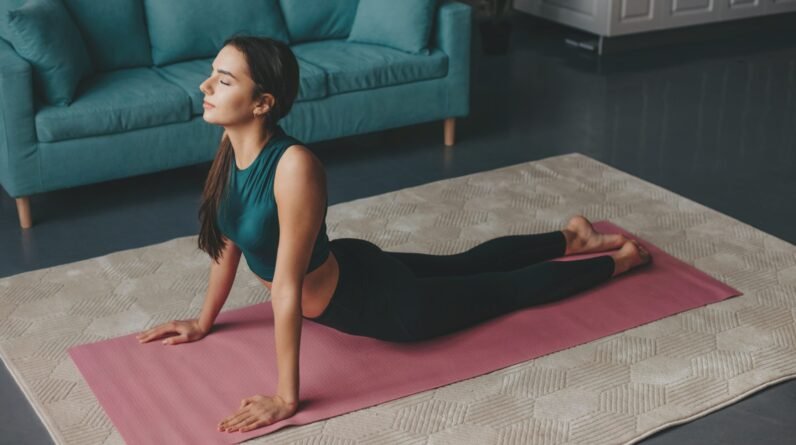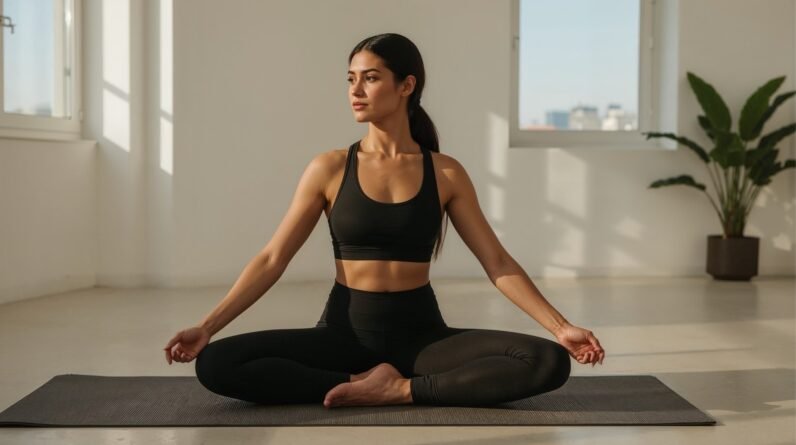
Sitting for long hours? These 10 exercises can help fix your posture and release stiffness. Practice them every day to feel relaxed!
If you spend long hours sitting, whether at a desk, on the couch, or scrolling through your phone, you are at risk of several health problems. Modern lifestyles have made sitting almost unavoidable, but our bodies are not designed to stay still for that long. Over time, this leads to stiffness, weak muscles, poor posture, and even chronic pain. What can be a quick solution for this? A few simple exercises can undo a lot of that strain.
According to sports physiotherapist Dr Karishma Sanghavi, consistent mobility work and posture-focused exercises help the body stay strong, flexible, and balanced. The expert shares with Health Shots some easy, beginner-friendly exercises you can practice daily to feel lighter, move better, and reduce discomfort.
What happens if you sit for long hours?
Sitting for extended periods slowly affects the body in ways we do not notice at first. Your legs and glutes weaken because they are not activated enough, which affects your balance and strength. Long sitting hours also slow down metabolism, making weight gain easier. Poor posture leads to back, shoulder, and neck pain. Over time, it can even affect heart health. A study published in the British Journal of Sports Medicine found that people who sit more have a 147 percent higher risk of experiencing a heart attack and stroke. Sitting too long can also increase stress and reduce overall mobility.
Exercises to correct body posture
Here are some of the best stretches and exercises to support body posture and boost mobility to reduce the side effects of long hours of sitting:
1. Glute bridge
This exercise strengthens weak glutes caused by prolonged sitting. They also improve lower-back stability and posture by supporting the spine. Follow these steps to perform it:
- Lie on your back with your knees bent and feet flat on the floor.
- Keep your arms by your sides and engage your core.
- Press your heels into the ground and lift your hips upward.
- Squeeze your glutes at the top and hold for a second.
- Slowly lower your hips back to the floor.
2. Hip flexor stretch (low lunge)
“This stretch helps release tight hip flexors that shorten during long sitting hours. It improves walking posture, reduces lower-back tension, and allows your hips to move more freely,” explains Sanghavi. Follow these steps to perform it:
- Begin in a kneeling position on the mat.
- Step your right foot forward into a lunge, keeping the knee above the ankle.
- Gently shift your hips forward until you feel a stretch in your left hip.
- Keep your chest lifted and shoulders relaxed.
- Switch sides after holding for 20–30 seconds.
3. Cat-cow stretch
Cat-cow increases spinal mobility and reduces stiffness caused by slouching. It also improves posture by encouraging smooth movement through the entire spine. Follow these steps to perform it:
- Start on all fours in a tabletop position.
- Inhale and arch your spine, lifting your chest and tailbone (cow).
- Exhale and round your spine, tucking your chin and pelvis (cat).
- Move slowly between these two positions, syncing breath with movement.
- Repeat for 8–10 rounds.

4. Chest opener stretch
This stretch counteracts rounded shoulders and tight chest muscles caused by screen time. It helps you stand taller and maintain an upright posture. Follow these steps to perform it:
You may also like


- Stand tall and clasp your hands behind your back.
- Gently lift your arms as you open your chest.
- Roll your shoulders back and down.
- Hold the stretch for 20–30 seconds while breathing deeply.
- Release slowly and relax your arms.
5. Thoracic spine rotation
Thoracic rotations improve upper-back mobility, reduce stiffness and help correct a hunched posture. They also enhance rotational movement for everyday activities. Follow these steps to perform it:
- Sit or kneel with your back straight.
- Place your hands lightly behind your head.
- Rotate your upper body gently to the right without moving your lower body.
- Hold for a second, then rotate to the left.
- Repeat the movement 8–10 times on each side.
6. Bird dog
This exercise strengthens the core, back muscles, and glutes, improving balance, stability, and posture. It also helps support the spine during daily activities. Follow these steps to perform it:
- Begin on all fours with your core engaged.
- Extend your right arm forward and left leg back.
- Keep your spine neutral and avoid arching.
- Hold for a moment, then return to the starting position.
- Switch sides and repeat 8–10 times.
7. Neck mobility circles
Sanghavi says, “These neck circles release tension in the neck, improve mobility, and reduce stiffness from looking at screens for long hours.” Follow these steps to perform it:
- Sit or stand comfortably with your shoulders relaxed.
- Slowly rotate your head clockwise in a full circle.
- Move gently and avoid forcing your neck into discomfort.
- Repeat the circle anticlockwise.
- Perform 5–6 circles in each direction.
8. Downward-facing dog
This stretch lengthens the entire back of the body, including hamstrings, calves, and spine. This helps improve posture and flexibility. It also reduces stiffness from long sitting hours. Follow these steps to perform it:
- Start in a plank position with hands under shoulders.
- Lift your hips upward to form an inverted V shape.
- Keep your spine long and press your heels gently toward the floor.
- Relax your neck and breathe deeply.
- Hold for 20–30 seconds.
9. Standing calf raises
Calf raises strengthen the calf muscles and improve ankle mobility, which helps support better balance and posture throughout the day. Follow these steps to perform it:
- Stand tall with your feet hip-width apart.
- Raise your heels slowly to stand on your toes.
- Hold the position for a second.
- Lower your heels back down with control.
- Repeat 12–15 times.

10. Spine rotation
This exercise relieves lower-back stiffness and increases spine flexibility, helping you sit and stand more comfortably. Follow these steps to perform it:
- Lie on your back with your knees bent and feet flat.
- Gently drop both knees to one side while keeping your shoulders on the floor.
- Hold the stretch for 20 seconds and breathe deeply.
- Bring your knees back to the center.
- Repeat on the other side.
Who should avoid these exercises or do them with caution?
Most of these movements are beginner-friendly, but certain people may need to be careful.
- Anyone with recent injuries, especially in the back, neck, knees, hips, or shoulders, should perform these exercises only after consulting a doctor or physiotherapist.
- If you have severe arthritis, a slipped disc, sciatica, uncontrolled high blood pressure, or are recovering from surgery, some stretches and core exercises may not be suitable.
- Pregnant women should also modify poses like downward dog, deep lunges, or intense back movements.
If any exercise causes sharp pain, numbness, dizziness, or discomfort that feels unusual, stop immediately.







